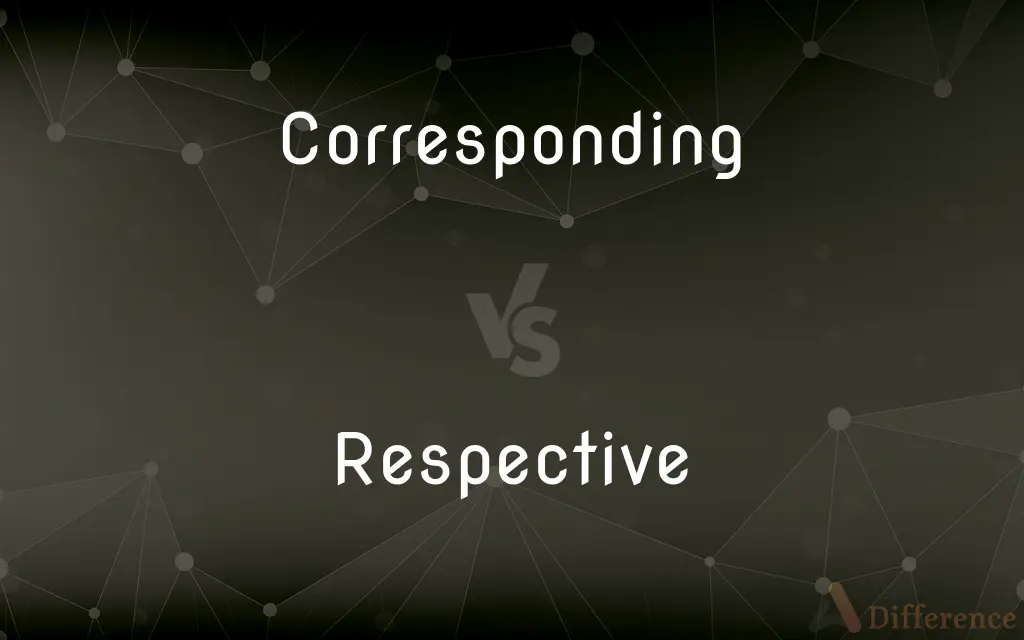Corresponding vs. Respective — What's the Difference?
By Tayyaba Rehman & Fiza Rafique — Updated on March 14, 2024
Corresponding indicates a direct relationship or equivalence between two elements, whereas respective implies individual or specific attributes or positions related to people or things in a sequence.

Difference Between Corresponding and Respective
Table of Contents
ADVERTISEMENT
Key Differences
Corresponding refers to elements that are directly equivalent or similar in function or position in different contexts. For example, the corresponding author of a research paper is the one who corresponds with the journal. On the other hand, respective denotes elements that are individually specific to each member of a group or sequence. For instance, team members have respective roles that define their specific responsibilities.
While corresponding elements often mirror each other across different situations or frameworks, respective elements highlight the unique or particular aspects assigned to each item or person within a group. This distinction is crucial when comparing items that are similar across contexts versus those that are uniquely defined within a single context.
Corresponding often implies a one-to-one relationship or a direct correlation, suggesting that if one element changes, its corresponding element changes in a related manner. Respective, however, underscores the individuality of elements within a group, without implying a direct correlation between them.
In situations where details are aligned or matched across two sets or groups, the term corresponding is used to highlight this alignment. Conversely, when discussing the individual characteristics or assignments within a single group, respective is used to emphasize these distinctions.
The use of corresponding can often indicate a more formal or structured relationship between elements, suggesting a predefined or established correlation. Respective, by contrast, allows for more flexibility and individuality, emphasizing personal or specific attributes rather than a fixed relationship.
ADVERTISEMENT
Comparison Chart
Definition
Relating to or matching something similar in another context
Belonging separately to each of several people or things
Relationship
Direct equivalence or similarity
Individual specificity within a group
Usage Context
Across different contexts or frameworks
Within a single context or group
Implication
One-to-one relationship or direct correlation
Individuality without direct correlation between elements
Formality and Structure
Often more formal and indicates a structured relationship
More flexible, emphasizing personal or specific attributes
Compare with Definitions
Corresponding
Matching or equivalent in a different context.
The corresponding secretary handles external communications.
Respective
Pertaining individually to each of several people or things.
Each team member carried out their respective tasks.
Corresponding
Serves to link two similar elements across contexts.
He will present the corresponding data from last year's study.
Respective
Common in organizational or team contexts.
They returned to their respective homes after the meeting.
Corresponding
Often used in academic or formal settings.
Please contact the corresponding author for more information.
Respective
Highlights individuality within a group or sequence.
The winners received their respective prizes.
Corresponding
Highlights similarities or direct correlations.
The corresponding figures in both reports are surprisingly consistent.
Respective
Emphasizes differences or individual attributes.
Participants shared their respective opinions during the debate.
Corresponding
Indicates a mirrored or parallel connection.
Each chapter in the book has a corresponding lecture in the course.
Respective
Signifies personal or specific attributes.
The siblings inherited their respective shares of the estate.
Corresponding
Having the same or nearly the same relationship.
Respective
Relating to two or more persons or things regarded individually; particular
Successful in their respective fields.
Corresponding
Accompanying another
A high corporate position and its corresponding problems.
Respective
Relating to particular persons or things, each to each; particular; own.
They returned to their respective places of abode.
Corresponding
Having been assigned the responsibility of written communications
A corresponding secretary.
Respective
(obsolete) Noticing with attention; careful; wary.
Corresponding
Participating at a distance from the rest of a group
A corresponding member of the bar association.
Respective
(obsolete) Looking toward; having reference to; relative, not absolute.
The respective connections of society
Corresponding
Present participle of correspond
Respective
(obsolete) Fitted to awaken respect.
Corresponding
A correspondence; the situation where things correspond or match.
Respective
(obsolete) Rendering respect; respectful; regardful.
Corresponding
That have a similar relationship
Respective
Noticing with attention; hence, careful; wary; considerate.
If you look upon the church of England with a respective eye, you can not . . . refuse this charge.
Corresponding
Answering; conformable; agreeing; suiting; as, corresponding numbers.
Respective
Looking towardl having reference to; relative, not absolute; as, the respective connections of society.
Corresponding
Carrying on intercourse by letters.
Respective
Relating to particular persons or things, each to each; particular; own; as, they returned to their respective places of abode.
Corresponding
Accompanying;
All rights carry with them corresponding responsibilities
Respective
Fitted to awaken respect.
Corresponding
Similar especially in position or purpose;
A number of corresponding diagonal points
Respective
Rendering respect; respectful; regardful.
With respective shame, rose, took us by the hands.
With thy equals familiar, yet respective.
Corresponding
Conforming in every respect;
Boxes with corresponding dimensions
The like period of the preceding year
Respective
Considered individually;
The respective club members
Specialists in their several fields
The various reports all agreed
Corresponding
Agreeing in amount, magnitude, or degree;
The figures are large but the corresponding totals next year will be larger
Common Curiosities
Is respective only used for people?
No, it can be used for any set of items or elements in a group.
Can corresponding be used to describe people?
Yes, it can describe roles or functions of people in different settings that are similar.
How do corresponding and respective differ in usage?
Corresponding is used when highlighting similarities across contexts, while respective is used for individual specifics within a group.
Can I use corresponding and respective interchangeably?
No, they have different implications and are used in distinct contexts.
When is it appropriate to use respective?
When pointing out individual characteristics or assignments within a single group.
What does corresponding mean?
Corresponding refers to things that are similar or equivalent in a different context.
In what context would I use corresponding?
When drawing parallels or indicating a direct equivalence between elements in different settings.
Does corresponding imply a stronger relationship than respective?
Yes, it often implies a more direct or mirrored relationship.
Can corresponding be used for comparison?
Yes, it's often used to compare and highlight similarities between different elements.
What does respective mean?
Respective means relating individually to each of several people or things in a group.
How does the use of corresponding affect communication?
It can add clarity and precision, especially in academic or formal discourse, by linking similar elements across different contexts.
Is respective used for collective items?
It's used to describe the individual aspects of items within a collective group.
Can respective imply a hierarchy?
It can, depending on the context, but primarily it emphasizes individuality without a direct correlation.
Do respective elements need to be related?
They are related by being part of the same group, but their specific attributes are individual.
Are corresponding elements always similar?
Yes, they typically mirror each other in function or position across contexts.
Share Your Discovery

Previous Comparison
Char vs. Charcoal
Next Comparison
Boathouse vs. HouseboatAuthor Spotlight
Written by
Tayyaba RehmanTayyaba Rehman is a distinguished writer, currently serving as a primary contributor to askdifference.com. As a researcher in semantics and etymology, Tayyaba's passion for the complexity of languages and their distinctions has found a perfect home on the platform. Tayyaba delves into the intricacies of language, distinguishing between commonly confused words and phrases, thereby providing clarity for readers worldwide.
Co-written by
Fiza RafiqueFiza Rafique is a skilled content writer at AskDifference.com, where she meticulously refines and enhances written pieces. Drawing from her vast editorial expertise, Fiza ensures clarity, accuracy, and precision in every article. Passionate about language, she continually seeks to elevate the quality of content for readers worldwide.
















































